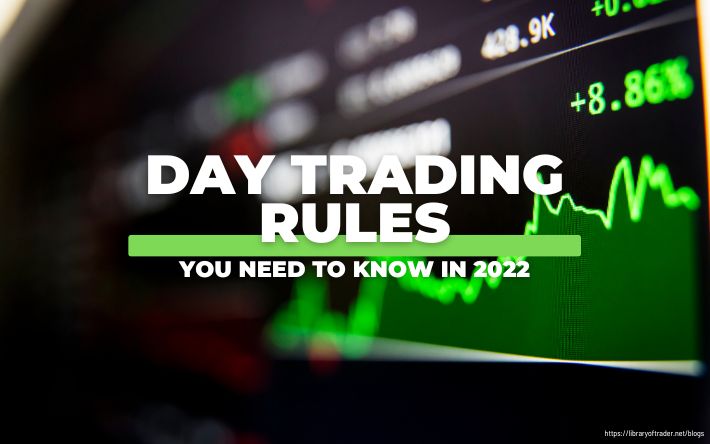Introduction
Few approaches to stock trading are as popular as day trading. Day traders are speculators who buy and sell stocks or other financial instruments on the same trading day in an attempt to profit from price fluctuations.

Day trading may appear to be a great way to make big money, but it is extremely risky and rarely profitable. Day trading is less likely to succeed even when compared to other notoriously volatile enterprises such as penny stock trading. If you want to try your hand at day trading stocks, here are the day trading rules and tips you should know before you begin.
What exactly is a day trade?
According to FINRA (Financial Industry Regulatory Authority), a day trade is defined as the purchasing and selling or the selling and purchasing of the same security on the same day in a margin account. This definition includes any type of security, including options. A day trade is also defined as selling short and buying to cover the same security on the same day.
A long security position held overnight and sold the next day prior to any new purchase of the same security; or a short security position held overnight and purchased the next day prior to any new sale of the same security are exceptions to this definition.
What is a pattern day trader?
A pattern day trader is defined by FINRA rules as any customer who executes four or more “day trades” within five business days, provided that the number of day trades represents more than 6% of the customer’s total trades in the margin account during that same five-day period. Customers should be aware that this rule is a bare minimum, and that some brokers use a slightly broader definition to determine whether a customer is a “pattern day trader.” Customers should contact their brokerage firms to see if a broader definition applies to their trading activities.
A broker-dealer may also label a customer as a pattern day trader if the broker-dealer “knows or has a reasonable basis to believe” that the customer will engage in pattern day trading. For example, if a customer’s broker-dealer provided day trading training to the customer prior to opening the account, the broker-dealer could label the customer as a pattern day trader.
What are the day trading margin rules for pattern day traders?
There are 02 requirements for pattern day traders, including:
Minimum Equity Requirement
A pattern day trader customer must have a minimum equity requirement of $25,000. This $25,000 requirement must be deposited and maintained in the customer’s account prior to any day trading activities. This $25,000 requirement cannot be met by a customer cross-guaranteeing separate accounts. Each day trading account is required to meet the $25,000 requirement on its own, using only the funds in that account.
If a customer’s account falls below the $25,000 minimum equity requirement, the customer will be unable to day trade until he or she deposits cash or securities into the account to bring it back up to the $25,000 minimum equity level.
Day Trading Buying Power
A pattern day trader may trade up to four times the customer’s maintenance margin excess as of the previous day’s close of business for equity securities. If a customer’s day trading buying power exceeds this limit, the customer’s broker-dealer will issue a day trading margin call. The customer has five business days to meet his or her margin call, after which his or her day trading buying power is limited to two times the customer’s maintenance margin excess based on the customer’s daily total trading commitment for equity securities.
If the customer does not meet the margin call by the fifth business day, the day trading account will be restricted to trading only on a cash available basis for 90 days or until the call is met, whichever comes first.
What are the other day trading pattern rules that traders should follow?
Every game, including day trading, has its own set of rules. If you are a new player, you must be aware of the fundamental set of rules. These rules are not legally binding, but they can assist you in making important decisions and provide broad guidelines.
5 Day Trading Pattern Rule:
#1: Do not treat day trading income as your sole source of income.
According to CNBC, a study published in June 2020 discovered that only 3% of nearly 1,600 Brazilian day traders tracked for a year actually made money. The study’s authors concluded that day trading for a living is “virtually impossible.”
Another study, published in October 2020, looked at Robinhood users’ day trading activity from May 2, 2018, to August 13, 2020. It discovered that large increases in Robinhood users are frequently accompanied by large price spikes, followed by “reliably negative” returns.
Day trading could be a fun but extremely risky hobby if you’re interested in it because it sounds exciting and money isn’t important to you.
#2: You need at least $25,000 to start day trading.
The Financial Industry Regulatory Authority requires day traders to keep at least $25,000 in their brokerage account, which is known as the “pattern day trading rules.” If you buy and sell a stock or other security four or more times in five business days, you are considered a pattern day trader and must follow the rules.
This rule also reflects another important reality: day trading requires a lot of money. Most trades will have relatively thin margins, especially after fees, so you’ll need to put a lot of money into them to make a significant profit. That is why beginners should practice with a stock trading simulator before investing real money.
#3: You may consider Margin Trading or Options Trading as one way to buy up more shares.
Because day traders make only a small profit (if any) on each share they trade, they require leverage to purchase more shares — typically in the form of margin trading. Margin trading is fraught with danger. Borrowing the maximum amount may result in substantial profits if you succeed, but it may also result in substantial losses if you fail. This can quickly put you in debt to your broker. You will also be charged interest on any money borrowed.
Options are another way to gain leverage. These are contracts that allow you to buy or sell a stock, security, or commodity at a predetermined price in the future. Because the contract price is much lower than the price of a stock, you can purchase contracts that represent far more shares than you could otherwise afford.
Trading stock options entails its own set of risks. Options contracts that do not become “in the money” are worthless, so a failed trade often results in the loss of everything you put into it. However, success typically magnifies your potential returns. And, unlike margin trading, you are not at risk of losing borrowed funds. Regardless, options can be very complex and should be thoroughly researched before making a decision.
#4: Investing for a short period will lead to higher taxes.
Because the capital gains tax favors long-term investors over short-term investors, day traders will face a higher tax bill for any profits they make. When you profit from the sale of stocks held for less than a year, you must pay the short-term capital gains tax rate, which can reach 37%. Gains on stocks held for more than a year are taxed at a much lower rate — no more than 15% for the majority of people, with a 20% cap.
#5: Considerable number of stocks when you’re a newbie in day trading.
As a beginner, it is best to limit yourself to one to two stocks per day trading session. It is easier to track and find opportunities when you only have a few stocks. If you trade multiple stocks at the same time, you may miss out on opportunities to exit at the right time.
Your strategy should be based on very specific stock trading information about the types of patterns that emerge in the way a particular stock trades, so you should have a clear idea of what price you want to buy and sell at. Market orders can easily execute at prices that differ from where stocks are trading when you enter them. The best strategy is to use limit orders that only execute on your terms.
Day Trading Pattern Rule: Frequently Asked Questions
- Why do I have to keep a minimum of $25,000 in equity?
Maintaining the minimum balance requirement of $25,000 has a few advantages: It safeguards you as a new trader. Many day traders give up day trading because they lose money.
The funds must be in the brokerage account because this is where the trading and risk are taking place. These funds are required to cover the risks associated with day trading. It is important to note that the Securities Investor Protection Corporation (SIPC) can protect up to $500,000 per customer’s securities account, with a cash claim limit of $250,000.
- What happens if the equity in my account falls below the required minimum?
If the account falls below the $25,000 minimum equity requirement, you will be unable to day trade until you deposit cash or securities into the account to bring it back up to the $25,000 minimum equity level.
- What if I continue day trade with less than $25,000?
The PDT (pattern day trader) rule states that traders with less than $25,000 in their margin account are not permitted to make more than three day trades in a rolling five-day period. So, if you make three day trades on Monday, you won’t be able to make any more until the following Monday.
When they realize this, many would-be day traders either give up or shift their focus to swing trading or the futures market.
- Why do day trading margin requirements matter?
The primary goal of the day-trading margin rules is to require that certain amounts of equity be deposited and kept in day-trading accounts, and that these amounts be sufficient to support the risks associated with day-trading activities. It was determined that previous day-trading margin rules did not adequately address the risks inherent in certain patterns of day trading and had encouraged practices such as the use of cross-guarantees, which did not require customers to demonstrate actual financial ability to engage in day trading.
- Is pattern day trading appropriate for you?
Day trading is not recommended for people with limited resources, little investment or trading experience, and a low risk tolerance. A day trader should be prepared to lose all of his or her money. Day trading should not be funded with retirement savings, student loans, second mortgages, emergency funds, assets set aside for purposes such as education or home ownership, or funds required to meet living expenses, given the risks.
- What happens if I am identified as a day trader?
If you are identified as a pattern day trader and do not have a portfolio value of $25,000 at the end of the trading day, you will receive an Equity Maintenance call and be barred from day trading for 90 calendar days, or until you end the trading day with a portfolio value of $25,000.
Conclusion
Day trading necessitates patience, skill, and discipline. Skill develops over time as you participate in markets and trade with discipline while devoting your time. This endeavor can be built on a solid understanding of some good day trading strategies.
Making money through day trading is extremely simple as long as you have the essential information and are willing to spend time doing enough extensive research. Otherwise, ignorance will soon find its way to devastate your fortune. Remember to keep your head cool, beloved traders! And stay tuned!


